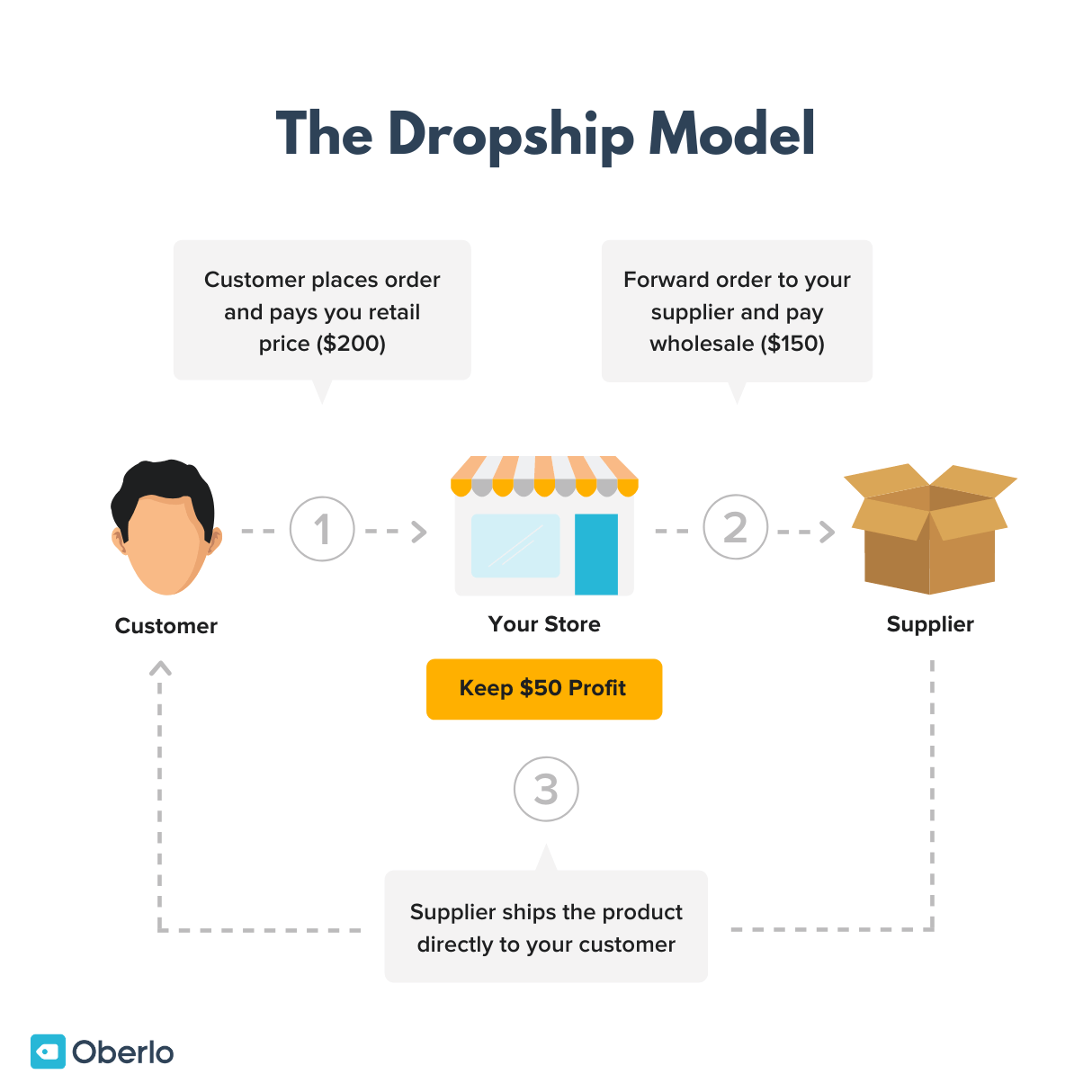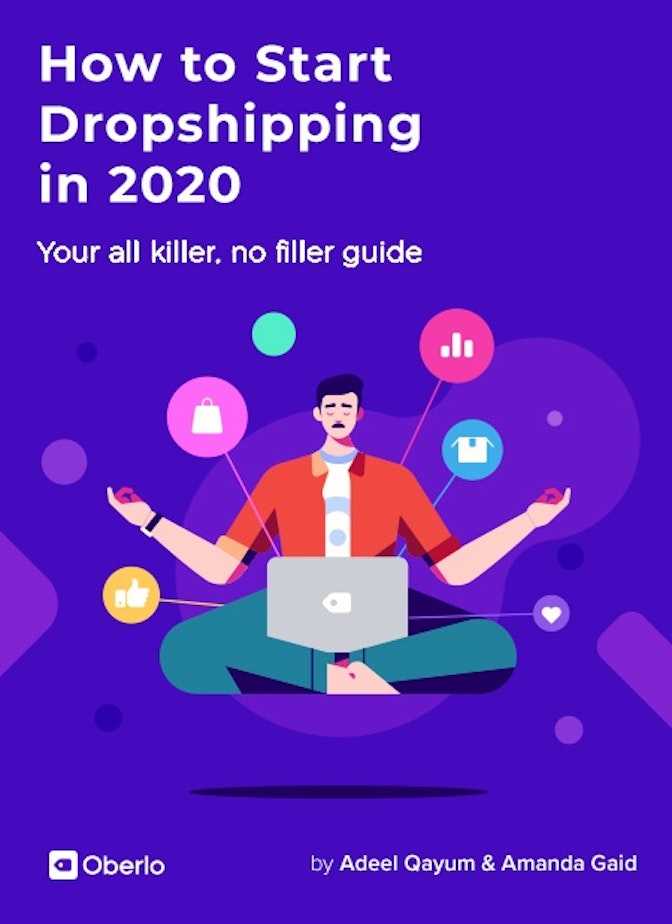If you’re anything like me, you’ve probably already skimmed through this book (or even just the table of contents) and thought, “Wow, this is long AF.”
That’s because it’s loaded with step-by-step instructions – everything you need to know to start your own dropshipping store.
There are three ways to read this guide:
- If you’re completely new to dropshipping, read it from beginning to end, following the steps described as you go. By the end of the book, you’ll have your store live and an in-depth understanding of how to start marketing.
- If you already have some dropshipping knowledge or progress on your store, use the guide as a reference. You can jump in and out of the chapters when you’re working through different stages of building and marketing your store.
- If you’ve already built your store, you can jump ahead to Chapter 7, which is where all the juicy marketing tips start.
Happy dropshipping! 🤟
| Meet the Authors
We’re Amanda Gaid and Adeel Qayum, two dropshipping and marketing enthusiasts who have been immersed in these topics for years. We’re all about sharing what we’ve learned so that we can help aspiring entrepreneurs get rid of the “aspiring” part and make their dreams a reality. When making this book, we each wrote our own chapters. You’ll see “Amanda here,” or “Adeel here,” at the beginning of every chapter so you can keep track of who’s talking to you. |
Amanda here. Since you’re reading this book right now, you probably can relate to one of these:
- You’re exhausted by your 9-to-5 office job and you want some more flexibility in life.
- You want to earn some extra money from the comfort of your couch (pants optional).
- You dream of being your own boss, but you’re not sure where to start.
No matter what brought you here, this book will tell you everything you need to know about how to start making sales with dropshipping.
If you don’t know anything about dropshipping, don’t worry! This is a complete beginner’s guide. No experience needed.
And by the end, you’ll know every single step you need to take to make money with your first online store.
You’ll even get plenty of advice from dropshipping pros – like Andreas and Alexander, who earned $114,110 in three months with their pet supplies store. That’s a whole lotta money.
But first, a very important note. I’m going to be honest with you right now: dropshipping isn’t a piece of cake. It takes a lot of work. Most of the pros you’ll hear from in this book failed on their first store (and second, and third…).
| 🏆 From the Pros
Andreas and Alexander’s success didn’t come easy, and it definitely wasn’t their first store that was their big money-maker. It was her third store, to be exact! In an interview with us, they offered up some super important advice for newbies. “When many people are first starting out with dropshipping, they’re held back by a particular fear: Why would anyone buy off me instead of Amazon? Yes, people could get it cheaper on Amazon, but on Amazon the marketing is very cold because everything looks the same. As long as your prices are okay, the product pages look good and the trust is there, then they will not look around anyway, they’ll just buy it from you.” |
Andreas and Alexander are the perfect example that you need to be creative, persistent and resilient. You need to plan for failure and have a backup plan ready to go. Most importantly, you need to be dedicated to kicking ass. 🙌💪
We’ll talk more about your mindset in the next chapter, so stay tuned.
For now, let’s get down to business.



How Dropshipping Works
Let’s start at the beginning: What is dropshipping, anyway?
| 📖 Ecommerce Dictionary
dropshipping: A business model that you can use to run your store without ever holding any inventory. When you make a sale, your supplier will ship your products from their warehouse, straight to your customer’s doorstep. You’ll never need to worry about storing, packaging, or shipping your products. |
Here’s a quick breakdown of how dropshipping works, and how merchants make their money.
- Your customer places an order on your Shopify website. Say the price is $200.
- You forward that order to your supplier and pay them the wholesale price, say $150.
- The supplier ships the product directly to your customer.
- You get to keep that $50 profit to put in your piggy bank or reinvest in your store.
Simple, right?
| 📖 Ecommerce Dictionary
merchant: A person who owns a store and sells products to customers. In this book, I use “merchant” to talk about a dropshipping store owner. supplier: The companies and people who sell wholesale products to merchants. They hold the stock and ship it to your customers for you. wholesale: When products are manufactured and sold in bulk. Because they’re made and sold in bulk, the supplier pays less to run their business. That’s why they can give you a big discount. |

Pros and Cons of Dropshipping
Before you dive into starting a business, you should understand what you’re up against. Here are some key advantages and disadvantages so you can weigh out if it’s the right choice for you.
Dropshipping Pros
Quick to start. You don’t even need any prior business experience! If you take some time to learn the basics, you can get started fast and learn the rest as you go along. Because ordering and shipping of items are taken off your hands, you get more time to focus on marketing.
Room to grow. As you grow, your business model doesn’t have to change very much at all. You’ll have to put more work into sales and marketing, but your day-to-day will stay more or less the same. Your costs to grow won’t be huge either, and you can grow at your own pace.
Demands less money to start. You can start dropshipping with minimal investment because you don’t have to purchase inventory upfront. Even as your business grows, your costs will be fairly low – your expenses will be limited to marketing and website setup fees.
Flexible. This is one of its biggest benefits. You get to be your own boss, set your own rules, and work at your own pace. Again, because you don’t have to buy any inventory upfront, you can easily list new products whenever you want – you only need a laptop and WiFi. Also, you can continually test and adapt until you find something that works – the business model gives you the flexibility to adjust strategies on the fly.
Simple to manage. Since the majority of dropshippers run their businesses solo, you can manage everything with little hassle. You can do everything all by yourself if you want to. Once you’ve found suppliers and gotten everything set up, you’re mostly responsible just for your online storefront, marketing, and customer service.
Dropshipping Cons
Low profit margins. This is especially true when you’re selling competitive items. When you have lower competition, you’ll have better margins, but usually not crazy high. That’s why you’ll need to focus on getting a lot of sales to make a lot of profit.
You don’t have a lot of control. When it comes to stocking products, order fulfillment, and shipping, things are out of your hands entirely. You have to rely on your suppliers to do everything right and work seamlessly. You’ll also need to learn how to deal with issues as you.
| 📖 Ecommerce Dictionary
fulfillment: All the steps a company takes between receiving a new order and placing that order into the customer’s hands. In dropshipping, there are much less steps to fulfillment than in a physical store or traditional ecommerce store. |
Customer service is tougher. To add to the point above, a lack of control makes it tough when you have customer complaints. You’ll have to take the blame for when the supplier does things wrong. But if you focus on keeping your customers happy, you should be able to manage in the long run.
Order processing can be hard. If you have more than one or two suppliers, things can get complicated. They might have different shipping options or different ways to process orders and bill you. That’s why I recommend starting with no more than three suppliers for your first try.
To learn more about pros and cons, check out this video.
Legal Considerations
Let’s look at how to make sure you’re following GDPR laws, as well as how to register your business.
GDPR Compliance
If you live in the European Union (EU) or sell to EU customers, GDPR is too important to ignore. Even if you don’t check off these boxes, you should keep it in mind.
First, let’s learn what GDPR is.
| 📖 Ecommerce Dictionary
GDPR: Short for General Data Protection Regulation. GDPR creates rules for how all European residents’ data must be managed. It took effect in May 2018 and impacts the handling of data related to everything from medical history to financial records to internet activity. |
Why Is GDPR Important?
GDPR is in place to safeguard the data of EU citizens. Under GDPR, organizations must follow rules of responsible data collection and usage to protect users’ rights and privacy.
By putting this responsibility on organizations, GDPR is giving EU individuals more rights to understand how and why their personal information is being collected and used. It also gives them the right to decide how they want this information to be used.
If you don’t comply with GDPR, it can result in pretty hefty fines and penalties – up to four percent of a company’s annual turnover! Case in point: a Polish retailer was hit with a huge fine of €650,000. 😱
Who Does GDPR Apply to?
Regardless of where you are based, GDPR applies to all companies that offer products or services to consumers in Europe.
So if your store is available in Europe, you probably have to comply with GDPR.
Just remember: GDPR compliance isn’t simply for European companies selling products to European customers. It covers any interaction with customers in Europe, period.
GDPR Compliance Checklist
The full GDPR is 88 pages and more than 50,000 words long. So we’ll spare you the details and just go over some key tips to make sure you’re compliant (which is a fancy word for “following the rules”).
- Make sure to get clear consent from your visitors. Don’t use pre-ticked boxes or assumptions that they want your content, like joining your email list.
- Collect only the necessary. The rule is, if you don’t need any piece of information, don’t ask for it.
- Be open about your GDPR compliance. Give them the option to opt-out, mention GDPR in your terms and conditions, and make your privacy statements clear and visible. If you have certified trust marks, show them off.
- Be transparent and honest. Full GDPR compliance may not be a walk in the park, if you’re straight with your methods, regulators may close one eye on any soft violations and even help you with it.
Please remember that this GDPR checklist only serves as a guide. Each organization will have its own specific GDPR requirements to fulfill and policy to state.
To learn more about GDPR, check out this helpful video.
Registering Your Business
When you first start your store, it’s not necessary to register your business just yet.
You can wait until you actually have sales, and you’ve proven that your store idea is successful. Like I mentioned earlier, it’s very common that your first – or second, or third – store idea won’t be as successful as you think. Totally normal.
Here are a few short steps for how to register a business in the U.S.
| 🕒 Tip Time
If you live in a different country, try Googling “how to register a business in [your country/city].” Look for resources on government websites so you can be sure everything is right. |
- Register with the United States Patent and Trademark Office (USPTO). It has to be a unique name that nobody has ever registered before, so use USPTO’s free tool to check if your business name is available.
- Choose your business entity. You can choose a limited liability company (LLC), or one of two incorporation types: an S corporation or a C corporation. Generally, an LLC requires less paperwork and expenses. But before you choose, make sure you understand how the entity type will affect your taxes. You can read more about that here.
- Get your employee identification number (EIN). This is a federal tax number that allows you to register your business on a federal level.
- Consider opening a business bank account. After you register your business, you can open a bank account for it. This can help you keep your business and personal money separate, which will help a lot when tax season comes. It can also help your business look more professional.



Dropshipping FAQs
Let’s look at some frequently asked questions (FAQs) about dropshipping.
How long does it take for customers to get their order?
The delivery time depends on where your supplier’s warehouse is and where the customer’s house is. It might take several days or a few weeks, but the rule of thumb for most dropshippers is two to four weeks.
| 🕒 Tip Time
If you’re concerned customers won’t be happy with the shipping time, make sure to be clear about how long it could take either on the product page or your store’s FAQ page. |
It also depends on the way the order is shipped. Most products have different shipping methods you can choose from, like ePacket. We’ll cover this more in Chapter 4.
How much money does it cost to start?
One of the best things about dropshipping is that it doesn’t require much investment. But it’s important that you consider the basic costs:
- Shopify subscription. After your free trial, a Basic plan is $39 a month plus a small transaction fee for each order.
- Marketing budget. You can do your own marketing for very cheap, but if you plan to run Facebook Ads, you should have at least a few hundred dollars to spend.
- Custom domain (optional).This is usually about $12 per year.
I also recommend setting aside part of your budget to order sample products. This will allow you to test the quality and potentially take your own photos.
What profit margins can I expect?
Your dropshipping profits will depend on these four things:
- Product price. This is the cost price given to you by the supplier. Buying items at close to wholesale costs is a great way to improve your overall profit.
- Shipping price. It refers to the cost incurred to get your products delivered to the customer’s doorstep. Options like EMS shipping can help you earn a higher profit.
- Marketing costs. These are the expenses you’ll incur while promoting your products via Facebook ads, influencers, etc.
- Price you charge/branding. This is the price you’ll charge after factoring in your product, shipping, and marketing costs. You can charge more for a product that’s branded as a premium.
We’ll talk more about pricing in Chapter 5.
How long does it take to make the first sale?
That depends on you. It can be your first day or after a month. It mostly depends on how much work you put in, the type of audience you’re targeting, whether those people actually like your products, and how much success your marketing activities have.
👉 I’m sure you have a million more questions. But don’t worry, we’re going to cover everything you need to get started in this book. Next up: how to manage your expectations and keep your attitude in the right place.





